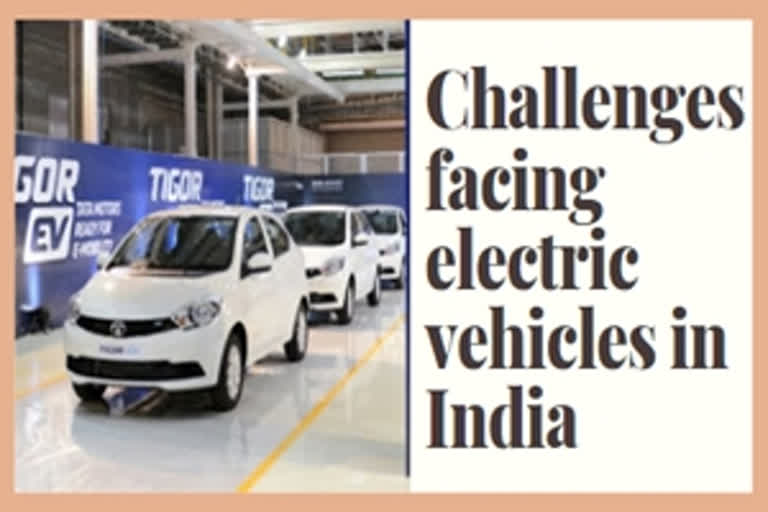Hyderabad: Future India will ride in electric vehicles (EVs) if one goes by the pronouncements of the country’s policymakers. The air will be cleaner. The noise level, as well as the oil import bills, will be down. And, if everything goes according to the Central government’s reported plan, India will be a manufacturing hub for EVs, just as China is of many industrial products now. But how near that future seems is an important question?
Hyundai Motor Co. launched India’s first electric SUV this summer and a few months later, the automaker finds itself on a lonesome road. In a nation of about 15 crore drivers, only 130 Kona SUVs were sold to dealers through August. That slow pace is emblematic of the difficulties carmakers face in establishing an electric foothold in the fourth-biggest auto market, even with committed government support.
The Kona sells for about Rs 25 lakhs while the average Indian earns about Rs 1.45 lakhs a year -- and the best-selling Maruti Alto costs Rs 2.80 lakhs. Yet Kona’s sticker price only kicks off the conversation about why EVs aren’t gaining traction in India -- there’s also a lack of charging infrastructure, a reluctance by banks to finance purchases and an unwillingness among government departments to use EVs as directed. Barely more than 8,000 EVs were sold locally during the past six years, according to data compiled by Bloomberg. China sells more than that in two days, according to Bloomberg NEF projections.
The affordability of electric cars in India is just not there. The government or the car companies do not expect that in the next two to three years there will be any real buying of electric vehicles. The segment still isn’t making meaningful strides more than four years after the government started promoting cleaner vehicles for one of the world’s most polluted countries. In February, the Centre committed to spending $1.4 billion on subsidies, infrastructure and publicity.
The potential of India’s EV market can’t be ignored. There are only 27 cars for every 1,000 Indians, compared with 570 for the same number of Germans, allowing global automakers an opportunity to challenge the dominance of Maruti - the unit of Japans Suzuki Motor Corp that sells every other car on local roads. Maruti is not introducing its first EV until next year. Tata Motors Ltd. and Mahindra & Mahindra build some base-level electric cars, yet they have a limited range or are exclusively for government use.More than half of the passenger vehicles sold in India last year cost Rs 5.80 lakhs or less. Electric cars won’t achieve price parity with gasoline-powered cars until the early 2030s, experts say. Consumers care about EVs, and the excitement is there, but that stops the moment they know the price.
Yet even for those who can afford the Kona, plugging in is problematic. India had an estimated 650 charging stations for cars and SUVs in 2018. China, the largest market for EVs, has about 456,000 charging points, official data shows. India’s inadequate charging infrastructure stems from locals chicken-and-egg approach to the issue.
At a conference in New Delhi last month, government officials and EV-component makers debated whether to create an adequate charging infrastructure to promote sales or whether to wait until there are enough EVs on the roads before building it out. We are pretty sure that people are going to like EV, but we would have our challenges like infrastructure. Those include first requiring that the buyer can install a charger at home. But there’s another factor besides income that makes it difficult to pay for one of these cars. Until there’s an established secondary market for EVs, banks and other institutions are hesitant to extend purchasing loans.
The government, both federal and local, will have to offer help for EVs to be adopted in the mass market. The budget in July included incentives such as reduced taxes, income tax benefits and import duty exemptions for certain EV parts. The first beneficiaries will be the ubiquitous scooters and motorcycles -- with subsidies meaning to support sales of 1 million two-wheelers, compared with 55,000 electric cars.
Yet the government still needs to practice what it’s preaching. Energy Efficiency Services Ltd., a joint venture of state-run companies responsible for replacing state vehicles with EVs, awarded its first tender in September 2017 for 10,000 cars. But as of July, agencies had accepted only 1,000 of them. Now EESL is offering vehicles to taxi companies.
EV experience across the world is limited. Even in countries where EVs are used, people’s choices and, patterns of vehicle use, as well as the infrastructure available, are different from that in India. Therefore every step on the EV route should be taken with care, for any setback will have serious economic and political consequences.
